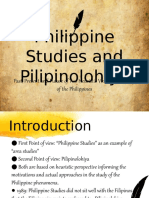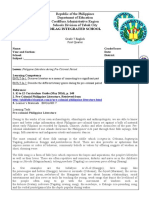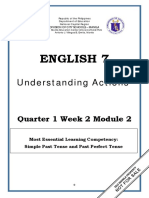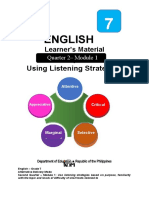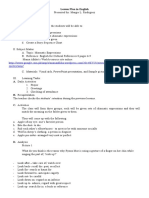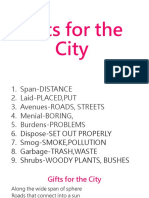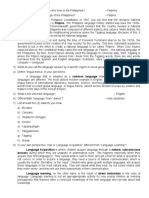Words of Wisdom: Happy Valley National High School Grade 7-English Subject Jose Jr. B. Orquia
Words of Wisdom: Happy Valley National High School Grade 7-English Subject Jose Jr. B. Orquia
Uploaded by
Olaybar EsoCopyright:
Available Formats
Words of Wisdom: Happy Valley National High School Grade 7-English Subject Jose Jr. B. Orquia
Words of Wisdom: Happy Valley National High School Grade 7-English Subject Jose Jr. B. Orquia
Uploaded by
Olaybar EsoOriginal Description:
Original Title
Copyright
Available Formats
Share this document
Did you find this document useful?
Is this content inappropriate?
Copyright:
Available Formats
Words of Wisdom: Happy Valley National High School Grade 7-English Subject Jose Jr. B. Orquia
Words of Wisdom: Happy Valley National High School Grade 7-English Subject Jose Jr. B. Orquia
Uploaded by
Olaybar EsoCopyright:
Available Formats
HAPPY VALLEY NATIONAL HIGH SCHOOL
GRADE 7- ENGLISH SUBJECT
Words of Wisdom
Folkliterature that reveal our ancestors wisdom. When she gathered proverbs
from various areas in our country, she declared that our elders lived by simple,
yet very meaningful rules of righteous living. In fact, she asserted that even the
Spaniards who colonized our country noticed how proverbs formed part of the
native spirit. Spanish missionaries were found to have translated such proverbs
and other oral expressions in Spanish in order for their fellow religious people to
learn our indigenous languages. By doing so, they were able to interact with the
early Filipinos their and eventually introduce the Catholic faith.
Proverbs are brief instructive expressions that suggest a specific action, behavior,
or judgment. Referred to by some scholars as the wisdom of many and the wit
of one, they are commonly written in the form of short assertions or poetic twoliners which have rhyme. It is interesting to note that people are easily struck by
proverbs when they are woven in conversations or writings. This is perhaps
because they have the power to teach people the more essential truths about life
and the complexity of living. Compared to lengthy narrations, descriptions, or
argumentations, proverbs are able to effect quickly a change in view or
disposition.
In Filipino, proverbs are called salawikain or sawikain. They prescribe norms,
impart a lesson, or emphasize traditions and beliefs in a community. In the
anthology of Damiana L. Eugenio, she classified proverbs into six categories: (1)
proverbs expressing a general attitude towards life and the laws that govern life;
(2) ethical proverbs recommending certain virtues and condemning certain vices;
(3) proverbs expressing a system of values; (4) proverbs expressing general
truths and observations about life and human nature; (5) humorous proverbs and
(6) miscellaneous proverbs. Below are examples of each category.
JOSE JR. B. ORQUIA
Damiana L. Eugenio, the mother of Philippine Folklore compiled and edited what
may very well be considered as the most comprehensive collection of proverbs in
our country. There is a limited number of works like this in existence. She spent a
lifetime collecting pieces
Joy is always guarded by sorrow.
Ang kapalaran ko di ko man hanapin, dudulog lalapit kung talagang akin.
(Tagalog)
The good fortune which is intended for me will come even without my seeking it.
2. Ethical proverbs recommending certain virtues and condemning certain vices
Walang utang na di pinagbayaran. (Tagalog)
No debt remains unpaid.
Dai mo pagpaagahan an magigibo mo ngonyan. (Bikol)
Do not put off for tomorrow what you can do for today.
Ayau mo in kahui pilaa ha kawaan mo bunga. (Tausug)
Do not cut the tree to get the fruit.
3. Proverbs expressing a system of values
Ti nasadot a baro cas carne a nadangro. (Ilokano)
A lazy young man is like foul-smelling meat.
Ang mga tulo singgot sa taong mangguibuhaton paga bayran gayud sa guihapon.
(Boholano)
Every drop of perspiration of an industrious man will be rewarded accordingly.
1. Proverbs expressing a general attitude towards life and the laws that govern
life
Isa ka tuig nga tiponon, isa ka takna wagwagon. (Hiligaynon)
Walang ligaya sa lupa na di dinilig ng luha. (Tagalog)
There is no earthly joy that is not watered with tears.
4. Proverbs expressing general truths and observations about life and human
nature
Say liket ban-bantayey ermen. (Pangasinan)
Huli man at magaling, ay naihahabol din. (Tagalog)
It takes only a moment to squander what took a year to save.
HAPPY VALLEY NATIONAL HIGH SCHOOL
GRADE 7- ENGLISH SUBJECT
A good thing is never too late.
Ti saan a matimtemec, nauyong no macaunget. (Ilokano)
The quite person is slow to anger but terrible when aroused.
JOSE JR. B. ORQUIA
ways of representing them in graphic, musical, or dramatic modes, we facilitate
their preservation. And through these, we strengthen our identity as a people.
___________________________________________________________________________
Ing mayap a babai, maiguit ya karing rubi. (Pampango)
A good woman is worth more than rubies.
5. Humorous proverbs
Ang gugma sang tigulang daw igui nga nagakamang. (Hiligaynon)
The love of an old man is like a snail that crawls.
Ako kanhi cabalyero nga walay kabilinggan; pagdawat sa matrimonio, sa hinanali
ng lawas mingniwang. (Cebuano)
I was formerly a gentleman without a care at all, but when I got married, my body
shrank and became small.
Kay tagal nanindahan, kabili-biliy balindang. (Tagalog)
After shopping for a long time, he ended up with a poor purchase.
6. Miscellaneous proverbs (typically expressive of specific realities to a certain
area)
Ing matudtud a pemangca e na balu lebasa ng sapa. (Pampango)
The sleeping boatman does not know the streams he has passed.
Mapipia nu sumavat ka a maysaosaod su sagap as canu caviden mu du
calawangan q manalamad su among. (Ivatan)
It is better to go home and weave a net than to stay on the shore and watch the
fish.
Dica agcapcapoy no bassit ti inapoy; dica agnengnengneng no bassit ti
diningdeng. (Ilokano)
Dont be too slow if theres only a little rice; dont be too shy if theres only a little
viand.
Our proverbs are not only witty expressions. They are also our cultural treasures.
As we continue to use them in various spoken or written forms and as we explore
The People of the Philippines by the Philippine Tourism Promotions
Board
1 The Filipino is basically of Malay stock with a sprinkling of Chinese, American,
Spanish and Arab blood. The Philippines has a population of 70 million, and it is
hard to distinguish accurately the lines between stocks. From a long history of
Western colonial rule, interspersed with the visits of merchants and traders
evolved a people of a unique blend of east and west, both in appearance and
culture.
2 The Filipino character is actually a little bit of all the cultures put together. The
bayanihan or spirit of kinship and camaraderie that Filipinos are famous for is said
to be taken from Malay forefathers. The close family relations are said to have
been inherited from the Chinese. The piousness comes from the Spaniards who
introduced Christianity in the 16th century. Hospitality is a common denominator
in the Filipino character and this is what distinguishes the Filipino. Filipinos are
probably one of the few, if not theonly, English-proficient Oriental people today.
Pilipino is the official national language, with English considered as the country's
unofficial one.
3 The Filipinos are divided geographically and culturally into regions, and each
regional group is recognizable by distinct traits and dialects the sturdy and
frugal llocanos of the north, the industrious Tagalogs of the central plains, the
carefree Visayans from the central islands and the colorful tribesmen and
religious Moslems of Mindanao. Tribal communities can be found scattered across
the archipelago. The Philippines has more than 111 dialects spoken, owing to the
subdivisions of these basic regional and cultural groups.
4 Some 80 percent of the population is Catholic, Spain's lasting legacy. About 15
percent is Moslem and these people can be found basically in Mindanao. The rest
of the population is made up mostly of smaller Christian denominations and
Buddhist.
5 The country is marked by a true blend of cultures; truly in the Philippines, East
meets West. The background of the people is Indonesian and Malay. There are
Chinese and Spanish elements as well. The history of American rule and contact
HAPPY VALLEY NATIONAL HIGH SCHOOL
GRADE 7- ENGLISH SUBJECT
with merchants and traders culminated in a unique blend of East and West, both
in the appearance and culture of the people of the Filipinos, or people of the
Philippines.
JOSE JR. B. ORQUIA
addition to his thousand eyes, has also eight hairy
heads. The epic Darangan speaks of Madale,
Bantugans brother and, Mabaning, Husband of
Lawanen, entering this section and retrieving the soul
of Bantugan.
The Origin of This World (Maranao)
from the Anthology of Philippine Myths by Damiana L. Eugenio
1 According to Maranaw folklore, this world was created by a great Being. It is not
known, however, who exactly is this great Being. Or how many days it took him to
create this world.
2 This world is divided into seven layers. The earth has also seven layers. Each
layer is inhabited by a different kind of being. The uppermost layer, for example,
is the place we are inhabiting. The second layer is being inhabited by dwarfs.
These dwarfs are short, plump, and long-haired. They are locally known as
Karibanga. The Karibanga are said to possess magical powers. They are usually
invisible to the human eye. The third layer of the earth which is found under the
sea or lake is inhabited by nymphs. These nymphs also possess certain magical
powers. It is stated in the story of Rajah Indarapatra that he met and fell in love
with the princess-nymph with whom he had a child.
3 The sky also consists of seven layers. Each layer has a door which is guarded
day and night by huge mythical birds called garoda. The seventh layer of the sky
is the seat of heaven which is also divided into seven layers. Every layer in the
sky is inhabited by angels. Maranaws believe that angels do not need food. They
all possess wings with which they fly.
4 Heaven which is found on the seventh layer of the sky is where good peoples
spirits go after death. Saints are assigned to the seventh layer while persons who
barely made it are confined to the lower most layer which is found at the
bottom of
Heaven
5 It is in heaven where we find the tree-of-life. On
each leaf of the tree-of-life is written the name of every
person living on earth. As soon as a leaf ripens or dries
and falls, the person whose name it carries also dies.
6 The soul of every person is found in tightly
covered jars kept in one section of heaven. This
particular section of heaven is closely guarded by a
monster with a thousand eyes, named Walo. Walo, in
Practice Makes Perfect!
Below is an exercise based on the contents of the article The Maranao Tribe from
Lake Lanao. Specify the verb, which will agree with its subject in each sentence.
Write your answers on a one fourth sheet of paper.
The Maranao, together with the Illanun and Maguindanao ____ 1. (is, are) an
indigenous Muslim group in Mindanao in southwestern Philippines. Their culture
and identity ____ 2. (reflects, reflect) general features of Southeast Asian tribes.
Each of these, however, ____ 3. (has, have) developed unique traditions. Every
historian or anthropologist who ____ 4. (studies, study) Mindanao tribes ____ 5.
(has, have) given common observations about the Maranao. Almost all Maranaos
____ 6. (is, are) Muslims, but some who live in the hills around Lake Lanao ____ 7.
(follows, follow) a version of Islam reflecting pre-Islamic beliefs and practices.
Many scholars ____ 8. (emphasizes, emphasize) that the Maranao, who ____ 9. (is,
are) the first inhabitants of the shores of Lake Lanao, still ____ 10. (inhabits,
inhabit) this region. The name Maranao ____ 11. (means, mean) "People of the
Lake" or "Lake Dwellers". Both ____ 12. (refers, refer) to the natives who settled
around Lake Lanao. Neither photographers or a writer ____ 13. (was, were) ever
able to capture in images or words the beauty of this lake. Lake Lanao, with the
Maranaos living around it ____ 14. (continues, continue) to be an attraction and
source of inspiration. More importantly, the spirit of the Maranaos ____ 15.
(thrives, thrive) because of its existence.
EXTRA EXTRA
Below is a students draft of an introduction for an article about diversity in the
Philippines. If a sentence observes proper subject-verb agreement, write C. If it
does not, rewrite the sentence. Write your answers on a half sheet of paper.
(1) Each tourist or guest who come to the Philippines is always amazed by our
cultural diversity. (2) Every island and region highlights a unique
HAPPY VALLEY NATIONAL HIGH SCHOOL
GRADE 7- ENGLISH SUBJECT
adventure. (3) A variety of traditions, dishes, celebrations, and many
others are offered to both local and foreign travelers. (4) Our rich past and
our promising future are discovered by every guest almost every day and
everywhere in the country. (5) For this reason, tourism experts, along with
the Department of Tourism believes that Its more fun in the Philippines!
JOSE JR. B. ORQUIA
(6) Northern Philippines boast of its old Spanish flavor, from architecture to
culinary traditions. (7) There are much pleasure to discover in the coasts and
shorelines of Central Philippines. (8) In Southern Philippines, one discovers the
rich Islamic backgrounds of our country. (9) Nobody has ever experienced
boredom in hopping from one island to another. (10) Either pleasure or warm
insights is taken home by every visitor in our shores.
You might also like
- Ang Wika Noon at NgayonDocument60 pagesAng Wika Noon at NgayonJess Cruz75% (4)
- Philippine Studies and PilipinolohiyaDocument23 pagesPhilippine Studies and Pilipinolohiyajessa prendol100% (1)
- Grade 7 English Competency 1-2Document3 pagesGrade 7 English Competency 1-2FGacadSabadoNo ratings yet
- English: Learning Activity SheetsDocument7 pagesEnglish: Learning Activity SheetsPrila NunezNo ratings yet
- Abakada:: Filipino AlphabetDocument23 pagesAbakada:: Filipino AlphabetCj Cabanada100% (2)
- Quarter 3 (Lesson 2) : The Mark of A True FilipinoDocument13 pagesQuarter 3 (Lesson 2) : The Mark of A True FilipinoMay ArzagaNo ratings yet
- 1QTR Eng7 Mod6-Revised PDFDocument8 pages1QTR Eng7 Mod6-Revised PDFBenedick Conrad R. GlifuniaNo ratings yet
- Q4 W7 - Celebrating Cultural Ties Through LiteratureDocument87 pagesQ4 W7 - Celebrating Cultural Ties Through LiteratureAngellie AntolanNo ratings yet
- Eng7 Q3 Module1Document21 pagesEng7 Q3 Module1Joams artsNo ratings yet
- Pre-Assessment in G8 - English First QuarterDocument2 pagesPre-Assessment in G8 - English First QuarterLOVILLADNo ratings yet
- English q2 Module 1Document18 pagesEnglish q2 Module 1Chaizell Loayon100% (1)
- ENGLISH 7 - Q1 - Mod7Document29 pagesENGLISH 7 - Q1 - Mod7Johnnry MarinasNo ratings yet
- LESSON 2 Module 3Document16 pagesLESSON 2 Module 3Vergel Bacares BerdanNo ratings yet
- Pliant Like The BambooDocument22 pagesPliant Like The BambooRamz Latsiv Yohgat100% (1)
- Module 1 - Lesson 1 Page 7-8 OnlyDocument12 pagesModule 1 - Lesson 1 Page 7-8 OnlyJosenia ConstantinoNo ratings yet
- Use The Passive and Active Voice Meaningfully in Varied Contexts (EN7G-III-c-2)Document4 pagesUse The Passive and Active Voice Meaningfully in Varied Contexts (EN7G-III-c-2)Nelissa Pearl ColomaNo ratings yet
- The Good Prince of Bantugan (Worksheet)Document3 pagesThe Good Prince of Bantugan (Worksheet)Gerald Herradura100% (1)
- English: Quarter 1 - 2: Genres of ViewingDocument22 pagesEnglish: Quarter 1 - 2: Genres of ViewingMelchor BalolongNo ratings yet
- I. Objectives: How's Your Day?Document5 pagesI. Objectives: How's Your Day?NnekaAtlas50% (2)
- DLP - Compare and ContrastDocument10 pagesDLP - Compare and Contrastabdulrahman akoyNo ratings yet
- English7 - Q2 - Mod1 - Using Listening Strategies Based On Purpose - v5Document21 pagesEnglish7 - Q2 - Mod1 - Using Listening Strategies Based On Purpose - v5Trisha Jane BlantucasNo ratings yet
- English 7: Understanding ActionsDocument16 pagesEnglish 7: Understanding ActionsAlbert Ng100% (1)
- English 7 Week 4Document26 pagesEnglish 7 Week 4Juliet Saburnido Antiquina100% (2)
- Week 2 - Quarter 1 JoseniaDocument5 pagesWeek 2 - Quarter 1 JoseniaAnonymous EVhKJ5XDiU100% (1)
- Pliant Like The Bamboo DLPDocument4 pagesPliant Like The Bamboo DLPGrace Z. GonzalesNo ratings yet
- English 8 - STDocument4 pagesEnglish 8 - STColeen Audrey BautistaNo ratings yet
- Activity Sheets7-8 (Using Appropriate Reading Style) W7-8Document7 pagesActivity Sheets7-8 (Using Appropriate Reading Style) W7-8Allan RemorozaNo ratings yet
- English 7 Q2 Module 1Document17 pagesEnglish 7 Q2 Module 1marjunampoNo ratings yet
- Lesson 2: Setting Aside DifferencesDocument16 pagesLesson 2: Setting Aside DifferencesPatrick AndayNo ratings yet
- Back UpDocument7 pagesBack UpEstelle Nica Marie DunlaoNo ratings yet
- Lesson 1: Completing An AnalogyDocument10 pagesLesson 1: Completing An AnalogyGian Carlo AngonNo ratings yet
- Week-4 1st-Day Literature Semi DetailedDocument4 pagesWeek-4 1st-Day Literature Semi DetailedMaria Angela EduardoNo ratings yet
- Engl 7 1ST Preliminary ExamDocument4 pagesEngl 7 1ST Preliminary ExamJulius BaldivinoNo ratings yet
- English 8 Q1M1 TrialDocument18 pagesEnglish 8 Q1M1 TrialVince GomezNo ratings yet
- Q4 English 7 - Module 7Document30 pagesQ4 English 7 - Module 7Lowell Lahoy DarayaonNo ratings yet
- FINAL Q4 Eng8 Week1 Module1 Grammatical-Signals-in-Idea-DevelopmentDocument10 pagesFINAL Q4 Eng8 Week1 Module1 Grammatical-Signals-in-Idea-Developmentrex henry jutaraNo ratings yet
- Quarter 1 WLP Grade 7 ENGLISHDocument8 pagesQuarter 1 WLP Grade 7 ENGLISHallen clark de chavezNo ratings yet
- English 7 Quarter 4 Week 5 Las 1Document2 pagesEnglish 7 Quarter 4 Week 5 Las 1Kemberly Semaña Penton100% (2)
- ENGLISH 7 - Q1 - Mod4Document28 pagesENGLISH 7 - Q1 - Mod4cyana andresNo ratings yet
- Q2 - LE - English 7 - Lesson1 - Week 2Document16 pagesQ2 - LE - English 7 - Lesson1 - Week 2irene.rueco21100% (1)
- English 7: Using Effective Techniques in Conducting An InterviewDocument32 pagesEnglish 7: Using Effective Techniques in Conducting An InterviewLaurice Olegario100% (1)
- Basic Factors of DeliveryDocument42 pagesBasic Factors of DeliveryJavil RomelNo ratings yet
- English: Quarter 3-Module 2: Oral Language Used For Specific PurposesDocument12 pagesEnglish: Quarter 3-Module 2: Oral Language Used For Specific PurposesKimberly Anne Babanto100% (3)
- Quarter 4Document13 pagesQuarter 4Clifford Lachica100% (1)
- English 7 - Q1 - Module-2-Lesson 2 For PrintingDocument30 pagesEnglish 7 - Q1 - Module-2-Lesson 2 For PrintingLilay BarambanganNo ratings yet
- Grade 7 English Syllabus 4th QuarterDocument15 pagesGrade 7 English Syllabus 4th QuarterJonel CarballoNo ratings yet
- A Detailed Lesson Plan in EnglishDocument10 pagesA Detailed Lesson Plan in EnglishRegine Gulane Briones NavarroNo ratings yet
- 3rd Quarterly Assessment in English 7Document4 pages3rd Quarterly Assessment in English 7SaluibTanMelNo ratings yet
- MATATAG LP Q1 Week2Document9 pagesMATATAG LP Q1 Week2lovejoycaylan2No ratings yet
- Athens Academy Grade 7 Module For MusicDocument9 pagesAthens Academy Grade 7 Module For MusicPat P. Monte50% (2)
- English Q1 Module 2Document18 pagesEnglish Q1 Module 2sheemz09260% (1)
- A Colorful Short Story: Grade 7-2 Quarter Project Performance TaskDocument2 pagesA Colorful Short Story: Grade 7-2 Quarter Project Performance TaskCaloy Bautista100% (1)
- English: Transcoding Linear and Nonlinear TextDocument12 pagesEnglish: Transcoding Linear and Nonlinear TextJM Tupil100% (1)
- Module 4 Grade 7Document8 pagesModule 4 Grade 7Gijoy Mangalas Lozano100% (1)
- Grade 7 - ODL - MELC1pdfDocument12 pagesGrade 7 - ODL - MELC1pdfCarmela SalvadorNo ratings yet
- Lesson Plan in English: Spiders/ampDocument2 pagesLesson Plan in English: Spiders/ampPatricia Ann Dulce AmbataNo ratings yet
- English 8 - Second Quarter-First Week: Objectives MelcDocument6 pagesEnglish 8 - Second Quarter-First Week: Objectives MelcJOEVANNIE S. PAGAURANo ratings yet
- Oral Language, Stance and BehaviorDocument21 pagesOral Language, Stance and BehaviorMailyn T. NgitngitNo ratings yet
- Gifts For The CityDocument24 pagesGifts For The CityRochelle Alava Cercado0% (1)
- English: Third Quarter - Module 3Document12 pagesEnglish: Third Quarter - Module 3Anna Agravante-SulitNo ratings yet
- The Six Basic Factor of DeliveryDocument13 pagesThe Six Basic Factor of DeliveryRonamina SantosNo ratings yet
- Damiana Eugenio ProverbsDocument3 pagesDamiana Eugenio ProverbsBJane Pelayo100% (2)
- Philippine LiteratureDocument69 pagesPhilippine LiteratureRhea Mae QuinicotNo ratings yet
- Flyer German KnowledgeDocument2 pagesFlyer German KnowledgeOlaybar EsoNo ratings yet
- BalagtazanDocument1 pageBalagtazanOlaybar EsoNo ratings yet
- A Detailed Lesson Plan in English For Grade 9 StudentsDocument3 pagesA Detailed Lesson Plan in English For Grade 9 StudentsOlaybar Eso72% (18)
- Berenice: by Edgar Allan PoeDocument6 pagesBerenice: by Edgar Allan PoeOlaybar EsoNo ratings yet
- Background Elements of LiteratureDocument5 pagesBackground Elements of LiteratureOlaybar EsoNo ratings yet
- Biography of Edgar Allan PoeDocument3 pagesBiography of Edgar Allan PoeOlaybar EsoNo ratings yet
- Language FocusDocument16 pagesLanguage FocusOlaybar Eso50% (2)
- Grade 8Document7 pagesGrade 8Olaybar EsoNo ratings yet
- Individual Performance Commitment andDocument5 pagesIndividual Performance Commitment andOlaybar EsoNo ratings yet
- Walk The MoonDocument3 pagesWalk The MoonOlaybar EsoNo ratings yet
- Class GamesDocument4 pagesClass GamesOlaybar EsoNo ratings yet
- Adam Lambert Lyrics 2Document1 pageAdam Lambert Lyrics 2Olaybar EsoNo ratings yet
- DO 2, S. 2015Document2 pagesDO 2, S. 2015Olaybar EsoNo ratings yet
- Summative Test Avearge MPS For The Second Quarter (SHS)Document2 pagesSummative Test Avearge MPS For The Second Quarter (SHS)Marissa Turla BroniolaNo ratings yet
- KOMFIL ReportDocument26 pagesKOMFIL ReportJameskier LomotosNo ratings yet
- Updated - Book ListDocument13 pagesUpdated - Book Listamvs20No ratings yet
- Q2 Week 1&2Document4 pagesQ2 Week 1&2Jonela MortosNo ratings yet
- My Ideal UniversityDocument14 pagesMy Ideal UniversityJanne Otura100% (2)
- Constitutional Provisions On Language in The PhilippinesDocument9 pagesConstitutional Provisions On Language in The Philippinesnina_jane_1No ratings yet
- Short Quiz For Eng 202Document2 pagesShort Quiz For Eng 202Ma. Cecilia BudionganNo ratings yet
- LS1 - A Language of Our OwnDocument6 pagesLS1 - A Language of Our OwnAlanie Grace Beron TrigoNo ratings yet
- Course Guide For Gec19 RizalDocument9 pagesCourse Guide For Gec19 RizalNoah Ras LobitañaNo ratings yet
- The Miseducation of The Filipino by Renato ConstantinoDocument10 pagesThe Miseducation of The Filipino by Renato ConstantinoCamille Chen100% (2)
- World Englishes, Philippine English, and English Language Education in The PhilippinesDocument10 pagesWorld Englishes, Philippine English, and English Language Education in The PhilippinesJoshuaNathanaelDaangDumaNo ratings yet
- Educ5910 LaurencelimDocument123 pagesEduc5910 Laurencelimapi-689550524No ratings yet
- Thesis Sa Filipino Maagang PagbubuntisDocument5 pagesThesis Sa Filipino Maagang Pagbubuntisdebbiebeasonerie100% (2)
- Letm20 Ans Form2 GenedDocument17 pagesLetm20 Ans Form2 GenedJoyanne Diwa100% (1)
- KonKom 113 Course Syllabus 1Document9 pagesKonKom 113 Course Syllabus 1Lainne ReyesNo ratings yet
- TULADocument39 pagesTULAandrewamat123No ratings yet
- Buwan NG WikaDocument14 pagesBuwan NG WikaMa Noreen Ragasa Eredia50% (2)
- Chapter 1-555Document81 pagesChapter 1-555Patrickaron DizonNo ratings yet
- National Commission For Culture and The Arts (NCCA)Document2 pagesNational Commission For Culture and The Arts (NCCA)Charlie ConcepcionNo ratings yet
- Thesis Chapter 3 TagalogDocument8 pagesThesis Chapter 3 Tagalogmaritzapetersonpaterson100% (2)
- Quiz Bee 1Document6 pagesQuiz Bee 1Merry Angel ApresuradoNo ratings yet
- Home Learning Guide ICT B - 11 - 9-13 - 2020Document12 pagesHome Learning Guide ICT B - 11 - 9-13 - 2020arun sivaNo ratings yet
- LANCE TIU Filipino Identity PDFDocument2 pagesLANCE TIU Filipino Identity PDFLance TiuNo ratings yet
- Expanding The Role of Philippine Languages in The Legal System: The Dim ProspectsDocument14 pagesExpanding The Role of Philippine Languages in The Legal System: The Dim ProspectsNiala AlmarioNo ratings yet
- sURING - bASADocument57 pagessURING - bASAEleazaar Cirilo100% (1)
- EED 4 - Pagtuturo NG Filipino Sa Elementarya II (Panitikan NG Pilipinas)Document10 pagesEED 4 - Pagtuturo NG Filipino Sa Elementarya II (Panitikan NG Pilipinas)Jayrick Gin PedroNo ratings yet
- Language Programs and Policies 4 LayersDocument2 pagesLanguage Programs and Policies 4 LayersRosemary Dawn FegideroNo ratings yet

